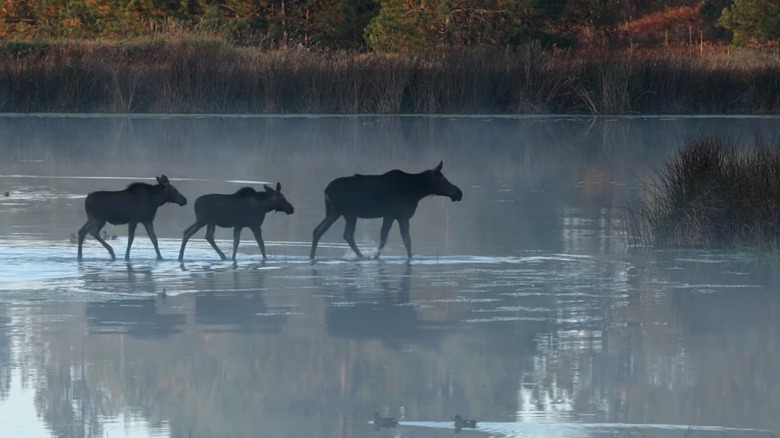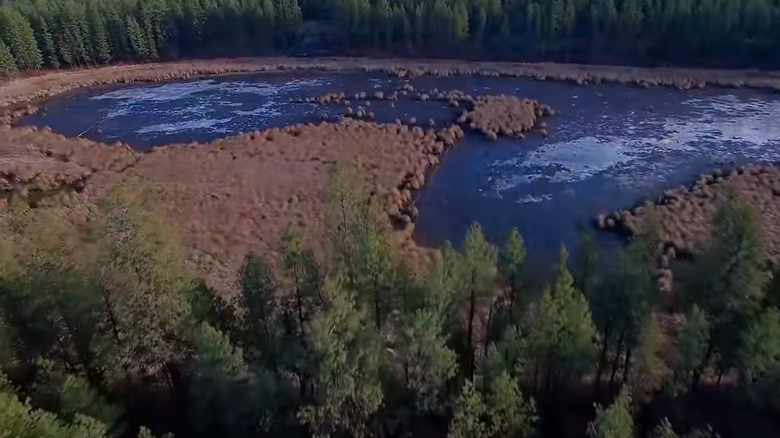Jimmy Bamis/YouTube
Imagine yourself wandering down a trail in a lovely spot full of ponderosa pines. It’s quiet, except for the tweeting of birds and the rustling of leaves under your feet. In the distance, you see a mama moose with her babies, and migrating birds flying overhead. If this sounds like paradise, you’re in luck. Just a little over 20 miles from the city of Spokane is the 23,000-acre Turnbull National Wildlife Refuge in Cheney, Washington. This gorgeous place has 3,300 of those acres set aside for public use, and there is so much to see. The park, situated on the edge of the Columbia River Basin, features pine forests, wetlands, a riparian habitat, and meadow steppes to explore. Even better? It’s always free to get in.
Not only are there 10 miles of trails to explore on foot, but you can also learn all about the flora and fauna that reside there. Start your journey at the visitor contact station, which is right at the trailhead for several hiking excursions. There is even an autoroute where you can spot many of the animals from your car. Here is everything you need to know about Turnbull National Wildlife Refuge, what you can do there, and some of the impressive mammals and birds you can see.
The creatures of Turnbull National Wildlife Refuge

Evergreen Wilderness/YouTube
Turnbull National Wildlife Refuge opens daily at 6 a.m., which is great, because the best time of day to see animals is in the early morning and evening. Fortunately it also stays open until 6 p.m. in the winter (November through April), and until 9 p.m. in summer (May through October). And these woods, skies, and waters are full of incredible animals to see — some 44 mammal species and more than 200 bird species! The best advice for seeing these majestic creatures is to be patient and quiet and let them get used to your presence. Perhaps use your car as a blind to help shield you from their sight, and be sure to bring your binoculars, camera, drinking water, and a field guide to get the best experience.
Though spring and fall are the best times to see migratory birds, like tundra swans, Canada geese, and ring-necked and gadwall ducks, there are opportunities for wildlife spotting all year long. From great horned owls in summer to northern flickers and nuthatches in winter, there are birds galore any time of year. And fear not if you want to see something larger: Badgers, beavers, American white pelicans, elk, moose, white-tailed and mule deer, river otters, and even cougars all call the refuge home. You might even hear the bugles of an elk bull as you hike. Just stay alert, be aware of your surroundings, and remember these tips to keep yourself safe from wildlife while hiking.
Hiking and exploring Turnbull National Wildlife Reserve

ReviewOutdoorGear/YouTube
Turnbull National Wildlife Refuge allows you to learn all about the animals of the park as you enter, with interpretive kiosks and a small store at the park’s headquarters. You can also access three main trailheads there: the accessible Pine Lake Trail, the kid-friendly Headquarters Trail — a quick 15-minute loop, and Stubblefield Trail, one of the longer hikes in the reserve at just under five miles long. If you don’t want to walk or have limited time, try the autoroute, a 5.5-mile road that can be done on foot, bicycle, or in a car, and takes you through some of the best waterfowl and animal-spotting areas. You can stop to park or pull off the road too.
Use this handy map of the park to plan your trip and consider the other hikes available, such as the other two wheelchair-accessible and kid-friendly trails: the half-mile Kepple Peninsula trail and the Blackhorse Lake Boardwalk that’s just over a tenth of a mile long, with prime wildlife viewing. The Bluebird Trail is just under 1.8 miles and an easy two-hour hike. And if you visit during a snowy winter (which is around one of every three), you can snowshoe, take a less intimidating snowy hike, or even ski off-trail from September through March. Just keep in mind some things you should never wear while visiting national parks when packing for your visit.

